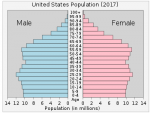- Joined
- Dec 2, 2015
- Messages
- 16,568
- Reaction score
- 7,253
- Location
- California Caliphate
- Gender
- Male
- Political Leaning
- Independent
The best US population estimate today is 328,233,846.
The reason I wonder is that there is an environment cost to population, and a social cost, and those topics are often the news de jure.
Where are you going to live, how are you going to live, and what kind of infrastructure will be need to accommodate everyone.
If history is any guide, the population will be in the big cities and the food will still be grown in the country. So we need to grow and move a hell of a lot of food, not to mention cooking, eating, and getting rid of garbage and sewage. Then we have to get people to and from work and school.
So what's your number?
The reason I wonder is that there is an environment cost to population, and a social cost, and those topics are often the news de jure.
Where are you going to live, how are you going to live, and what kind of infrastructure will be need to accommodate everyone.
If history is any guide, the population will be in the big cities and the food will still be grown in the country. So we need to grow and move a hell of a lot of food, not to mention cooking, eating, and getting rid of garbage and sewage. Then we have to get people to and from work and school.
So what's your number?
Last edited:


